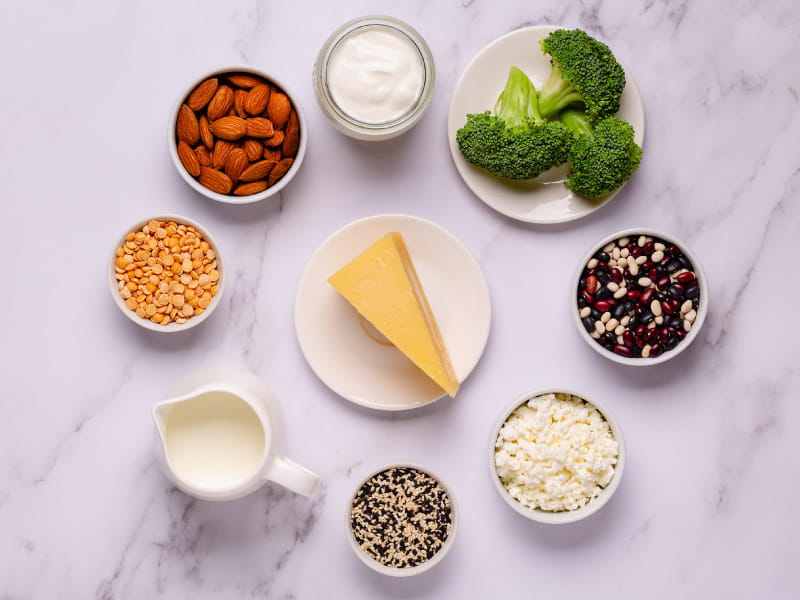Cracking the calcium code to understand its role in health
By Michael Merschel, American Heart Association News

People seeking straightforward nutrition advice might have a bone to pick with calcium, a building block of health that can start to seem like a piece from a complicated puzzle.
Luckily, the basics – such as understanding why you need it and how to make sure you're getting enough – don't have to be puzzling at all.
"Calcium is important for overall health," said Dr. Kristina Petersen, an associate professor of nutritional sciences at Penn State University in University Park, Pennsylvania. "And we know inadequate intake or deficiency causes health problems."
Calcium is best known as the building material for your skeleton. More than 99% of it is in bones and teeth. But calcium also plays several roles related to heart health. It may help regulate blood clotting, heart rhythms and how blood vessels dilate and contract.
People whose diets are deficient in calcium have a higher risk of high blood pressure, said Dr. Martha Gulati, director of preventive cardiology in the Smidt Heart Institute at Cedars-Sinai in Los Angeles. But exactly how that works isn't fully understood, said Gulati, who also is president of the American Society for Preventive Cardiology.
Dietary calcium can be tricky to study, Petersen said, because it's difficult to discern its effects from other nutrients in calcium-rich foods.
The recommended daily allowance for calcium is 1,000 to 1,200 milligrams a day for adults, depending on age; teens and pre-teens need slightly more. But this is where conversations about calcium can start to sound like a puzzle, or the seating arrangements at a high school cafeteria – because it's all about who calcium is fitting in with at mealtime.
Without adequate vitamin D, for example, your body can't absorb much calcium from food. That's particularly important for bone health, Petersen said. (Few foods contain vitamin D naturally, but your skin makes it when exposed to sunlight, and it's routinely fortified into milk and milk substitutes such as oat milk.)
Meanwhile, some foods contain compounds that bind with calcium and prevent the body from using it. For example, spinach has a fair amount of calcium, but only about 5% ends up being bioavailable – that is, absorbed into the body. By comparison, about 32% of the calcium in milk is bioavailable.
People who don't want to fetch a calculator or open a spreadsheet to plan each meal might be tempted to reach for a calcium supplement to boost their levels. Not so fast.
First, you should consult with your primary care physician before taking any supplement, Petersen said. And although some people might have a valid reason to take one, in general, most can get the calcium they need in their diet.
Some studies, Petersen said, have found that high levels of calcium from supplements actually can be bad for heart health. Gulati, who co-wrote the National Osteoporosis Foundation and American Society for Preventive Cardiology guidelines about calcium supplements in 2016, said that studies overall have been contradictory about calcium supplements' safety and benefits.
"Ultimately, I think that the best way to get nutrients is through our food," Gulati said. "I don't advocate for a lot of supplements unless somebody truly can't get it from food."
Happily, experts have an easy answer to the question of how to get the calcium you need without keeping a nutrition textbook handy: Just eat a range of healthy foods throughout the day.
"That should be sufficient," Gulati said. Sure, you could schedule your meals to avoid calcium-binding foods at the same time you're eating those that are calcium-rich, she said. "But I think that's a very difficult way to eat."
By eating a variety of healthy foods throughout your day, chances are you're not always eating something that's calcium-binding, she said, and you're probably getting something else that's beneficial.
"And the thing about calcium is that there are actually lots of sources out there," she said.
Most bioavailable calcium is going to come from dairy products such as low-fat milk, yogurt and cheese, Petersen said. Federal dietary guidelines recommend that adults have three one-cup servings of dairy a day. The DASH (Dietary Approaches to Stop Hypertension) eating plan also includes two to three servings of low-fat or fat-free dairy. (Butter is technically dairy but is not a good source of calcium, she said.)
Plant-based milks can be a good dairy alternative for people who are lactose intolerant or who don't consume animal-based products. "However, you do need to make sure that you are choosing a calcium-fortified one," Petersen said.
Gulati happens to be vegan and draws on a long list of non-dairy options to meet her needs. "Edamame is one great source of calcium," she said. "Tofu also is a great source. Nuts, particularly almonds, are another good source," as are leafy greens such as bok choy and collard greens, especially when cooked.
Other sources include beans, winter squash, sardines and canned salmon.
Petersen said she finds dairy to be a convenient way to get her calcium. She likes milk in her coffee and is a big fan of yogurt and its many portable forms. "You can just put one in your bag and take it to work, and that's your snack."





